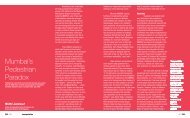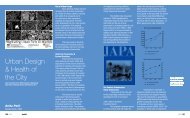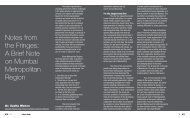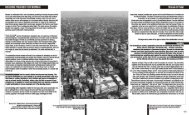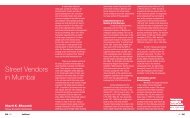Homeless in Neoliberal Cities: View from Mumbai - Urban Design ...
Homeless in Neoliberal Cities: View from Mumbai - Urban Design ...
Homeless in Neoliberal Cities: View from Mumbai - Urban Design ...
Create successful ePaper yourself
Turn your PDF publications into a flip-book with our unique Google optimized e-Paper software.
elaborately <strong>in</strong>forms about the rental<br />
hous<strong>in</strong>g be<strong>in</strong>g constructed for the slum<br />
dwellers (around 5,00,000 houses) <strong>in</strong><br />
the <strong>Mumbai</strong> Metropolitan Region. One<br />
must not forget that one of the dictates<br />
of the JNNURM is to make Indian cities<br />
slum-free. Accord<strong>in</strong>gly, the Maharashtra<br />
Government is keen on relocat<strong>in</strong>g the<br />
slum dwellers outside the city with the<br />
help of projects like Integrated Hous<strong>in</strong>g<br />
and Slum Development Program (IHSDP),<br />
Rajiv Awas Yojana (RAY), Basic Services<br />
to <strong>Urban</strong> Poor (BUSP), etc. Even though<br />
one may doubt the effectiveness of these<br />
schemes for the target population and<br />
the modalities of their implementation,<br />
it is very clear that all these schemes<br />
are meant for the slum dwellers and<br />
not for the homeless. Several NGOs<br />
have criticised the manner <strong>in</strong> which the<br />
government has equated the homeless<br />
with the slum dwellers <strong>in</strong> the affidavit<br />
(Affidavit, Government of Maharashtra,<br />
2010). Although the government<br />
correctly identifies the problems faced<br />
by the homeless <strong>in</strong> the city, nowhere <strong>in</strong><br />
the document there is any mention of<br />
any policy prescription to address these<br />
problems. Rather, when the homeless<br />
population <strong>in</strong> the city are found work<strong>in</strong>g<br />
as construction workers, rag pickers,<br />
<strong>in</strong>formal porters, garbage workers, flower<br />
market workers, workers <strong>in</strong> several<br />
other unorganised occupations, the<br />
Maharashtra government <strong>in</strong> its affidavit<br />
repeatedly mentions them as beggars,<br />
suggest<strong>in</strong>g that they be accommodated<br />
<strong>in</strong> beggars’ homes. One must note that<br />
under Indian law, beggars are to be<br />
treated as crim<strong>in</strong>als. Accord<strong>in</strong>g to a group<br />
of NGOs, beggars’ homes are also not<br />
voluntary spaces but custodial <strong>in</strong>stitutions<br />
that take away the fundamental right<br />
to liberty of the <strong>in</strong>mates (Collective for<br />
<strong>Homeless</strong> Citizens, 2010). The State thus<br />
is found to have taken a perspective of<br />
surveillance with regard to the homeless<br />
than assist<strong>in</strong>g them to have a m<strong>in</strong>imum<br />
dignified status. Even though the National<br />
Slum Policy of India recognises the poor<br />
as an extremely important element of<br />
the urban labour force, contribut<strong>in</strong>g<br />
substantially to productivity and labour<br />
market competitiveness for which they<br />
deserve affordable land, house site and<br />
services <strong>from</strong> the urban local bodies,<br />
the Maharashtra Government considers<br />
the urban homeless as a negative<br />
section of the population who are<br />
unable to earn, who loiter as vagabonds<br />
around bus stations, pavements,<br />
market squares etc (Government of<br />
Maharashtra, 2010). This means that<br />
the State is openly crim<strong>in</strong>alis<strong>in</strong>g the<br />
urban poor and spatialis<strong>in</strong>g urban crime<br />
with a def<strong>in</strong>ite bias aga<strong>in</strong>st them.<br />
The above state perspective on<br />
the urban poor is essentially associated<br />
with the urban transformation agenda of<br />
the neoliberal regime where<strong>in</strong> citizens<br />
hav<strong>in</strong>g less affordability and <strong>in</strong>capacity<br />
to rema<strong>in</strong> <strong>in</strong> a competitive framework are<br />
gradually pushed out <strong>from</strong> the ma<strong>in</strong>stream<br />
official agenda of city plann<strong>in</strong>g.<br />
Summ<strong>in</strong>g Up<br />
The process of urban<br />
transformation under neoliberalism<br />
entails repeated bouts of economic and<br />
spatial restructur<strong>in</strong>g that has a dist<strong>in</strong>ct<br />
class dimension s<strong>in</strong>ce it is the poor, the<br />
underprivileged and those marg<strong>in</strong>alised<br />
<strong>from</strong> the political power that suffer<br />
the most <strong>from</strong> the process. Violence is<br />
seen everywhere <strong>in</strong> the process of their<br />
eviction <strong>from</strong> urban space <strong>in</strong> the form<br />
of demolition of slums, eviction of poor<br />
tenants <strong>from</strong> dilapidated build<strong>in</strong>gs or<br />
squatters <strong>from</strong> pavements. Way back<br />
<strong>in</strong> the 19th century, Haussmann tore<br />
through the old Parisian slums, us<strong>in</strong>g<br />
powers of expropriation <strong>in</strong> the name of<br />
civic improvement and urban renewal.<br />
Much of the work<strong>in</strong>g class areas of the<br />
city were deliberately taken over (Harvey,<br />
2008) <strong>in</strong> order to cleanse areas that<br />
could throw a challenge to the prevail<strong>in</strong>g<br />
political order. In 1872, Engels wrote<br />
about the process of redevelopment <strong>in</strong><br />
depressed areas of cities that could not<br />
suit the changed circumstances. He noted<br />
that rent could not <strong>in</strong>crease beyond a<br />
certa<strong>in</strong> level <strong>in</strong> areas that accommodated<br />
the workers, thereby mak<strong>in</strong>g them<br />
vulnerable to urban renewal. History of<br />
modern urban growth based on the above<br />
methodology went on repeat<strong>in</strong>g itself<br />
dur<strong>in</strong>g the entire 20th century <strong>in</strong> several<br />
cities of the world that f<strong>in</strong>ally, s<strong>in</strong>ce the<br />
1980s, with the neoliberal regime gett<strong>in</strong>g<br />
more <strong>in</strong>tense, has become more brazen,<br />
legalised and policy-based. In the 1990s,<br />
<strong>in</strong> Seoul, construction companies and<br />
developers while <strong>in</strong>vad<strong>in</strong>g the workers’<br />
neighbourhoods, not only bulldozed<br />
the hous<strong>in</strong>gs but all the possessions<br />
that these people had (Harvey, 2003).<br />
Such practices have now become a<br />
structural component of the contemporary<br />
urban development process <strong>in</strong> several<br />
countries <strong>in</strong>clud<strong>in</strong>g India, as well. The<br />
urban homeless <strong>in</strong> this cruel framework<br />
of modernised transformation are the<br />
most ill-fated and wretched group. They<br />
cannot have any claim on any space to<br />
call their own. They only have the public<br />
space to use for their private activities.<br />
The proliferation of anti-homeless<br />
laws and the <strong>in</strong>human approach of the<br />
State towards the homeless <strong>in</strong> several<br />
cities, accord<strong>in</strong>g to Zuk<strong>in</strong> (1995), are<br />
noth<strong>in</strong>g but products of negotiations,<br />
with<strong>in</strong> the realm of law, to remove such<br />
people <strong>from</strong> the negotiator’s table.<br />
In other words, these laws have an<br />
implicit goal of redef<strong>in</strong><strong>in</strong>g the public<br />
rights so that only the housed may have<br />
access to them (Mitchell, 1997a).<br />
The situation of the homeless<br />
<strong>in</strong> <strong>Mumbai</strong> is no different <strong>from</strong> other<br />
cities. Like their fellow folks <strong>in</strong> any<br />
other city, they too are largely left to<br />
fend for themselves. The State not only<br />
does not <strong>in</strong>clude them <strong>in</strong> any policy<br />
prescription of urban development,<br />
rather it plays a formidable role <strong>in</strong> their<br />
eviction and dispossession. Although<br />
the urban development plans boast<br />
of ‘<strong>in</strong>clusiveness’, <strong>in</strong> practice they<br />
are brazenly anti-poor and the least<br />
democratic (Banerjee-Guha, 2008).<br />
For example, the Plann<strong>in</strong>g Commission<br />
has recently announced that any<br />
<strong>in</strong>dividual, spend<strong>in</strong>g Rs 20 per day on<br />
her/his basic needs, cannot be termed<br />
poor and will not be eligible to receive<br />
subsidies and social benefits <strong>from</strong> the<br />
Central government that a BPL (Below<br />
Poverty L<strong>in</strong>e) <strong>in</strong>dividual can claim. What<br />
can be more anti-poor than this<br />
Despite the above scenario,<br />
collective pressure is build<strong>in</strong>g up <strong>in</strong><br />
several cities through <strong>in</strong>itiatives of<br />
social organisations, concerned citizens<br />
and academic debates to challenge<br />
the anti-homeless stance of the State<br />
policies. It is high time that the State is<br />
pressurised to implement the <strong>in</strong>clusive<br />
aspects of the policy statements and<br />
recognise the fundamental rights of the<br />
urban homeless who essentially go to<br />
make a constructive and functionally<br />
active section of the population. A well-<br />
072 / 03 hous<strong>in</strong>g<br />
03 / 073



